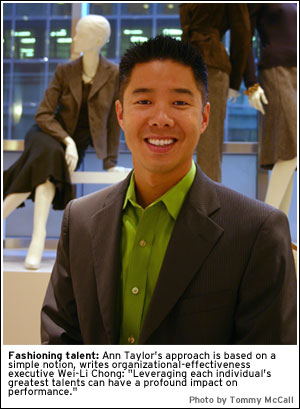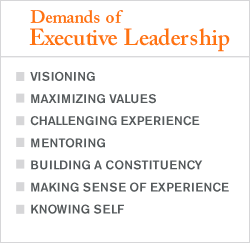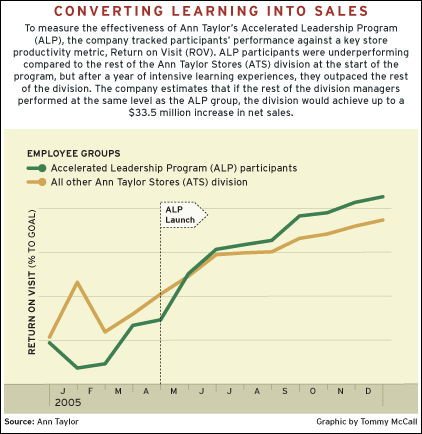At a talent-management conference that I recently attended, executives from many industries discussed their best practices in workplace learning and development. These execs were from organizations regarded as leaders in this area, so I was amazed at how the attendees listened in envy as the speakers compared curricula, state-of-the-art learning centers, and overall spending on learning. I was amazed because it was unclear to me whether that investment had paid off.
 |
So I asked the speakers, "How has the investment in learning affected your business results?" Responses varied from driving retention to improving employee morale. But in the end, it was clear that the learning strategies were more of a "nice to have" element of their organization rather than a "need to have" requirement. I left the conference disappointed at the lack of focus on, or regard for, how learning practices had measurably improved performance results in these organizations.
At Ann Taylor, we've taken a different approach. Our learning and development strategy is aligned with our overall business strategy. What's more, our measurement shows a clear relationship between our talent investment and bottom-line business performance.
A better way
Near the end of 2004, I had the opportunity to meet with Kay Krill, who at the time was the president of Ann Taylor brands. We discussed the issues affecting our workforce and how we could get better solutions from the human resources department. We knew, for example, that Ann Taylor had invested tens of millions of dollars over several years in sales training that yielded no significant improvement in sales productivity. Furthermore, our best leadership talent pipelines were external. We needed a way to develop an internal source of leaders who would be ready to meet the growth demands of our business.
"We need to find a better way" was Kay's challenge. The first step toward a solution was to consolidate our training departments into a function that we called Organizational Effectiveness (OE). Rather than simply deploying training sessions, OE was responsible for developing and measuring the effectiveness of our performance management and talent investment strategies for the corporate office and stores. The OE team was staffed from within. Most staff members had been with Ann Taylor for 10 years or more and had a proven performance record; we felt that business acumen was more important for OE than familiarity with employee training concepts.
With the right players in place, we started to develop our core philosophy and strategy for measuring our impact. Our talent strategy was based on this simple notion: Leveraging each individual's greatest talents can have a profound impact on performance.
This became the foundation of our talent investment philosophy. We moved away from competency-based models -- we felt we would gain more impact with an individualized approach -- and shifted to a focus on talent. We chose the Clifton StrengthsFinder -- an online assessment that reveals individuals' top talent themes, such as Achiever, Strategic, and Relator -- as our tool for discovering talent. And we created Ann Taylor University to help employees learn how to use their talents to drive business outcomes, with all learning branded as "Taylored to Your Growth."
Once the basic philosophy was established, our next step was to find the linkage between business impact and every talent investment concept we proposed. Finding the linkage -- or lack of one -- provided an effective way to allocate resources based on where our investment would yield the best return. Using this method, we decided to focus on our best talent at the store-manager and district-manager levels -- which was where we found the most direct correlation to sales productivity.
A program is born
The Ann Taylor Stores division, which operated more than 350 stores in 2005 with net sales of $873.9 million, was an ideal pilot group for our investment strategy. The division already had a talent assessment process in place in which leaders discussed their teams' performance and potential with relative objectivity. This process identified 11 store managers and district managers with the potential to accelerate the performance of their stores or districts -- and with the potential to grow into leadership roles at Ann Taylor.
We started with a basic hypothesis: We would invest in these managers' development for 12 months, then compare their business results against other managers who did not receive the same in-depth learning.
This program -- the Accelerated Leadership Program, or ALP -- included two key learning experiences. The first, the Clifton StrengthsFinder, was designed to help these managers develop an intense awareness and understanding of their talents. Managers also studied the Seven Demands of Leadership [now the Demands of Executive Leadership]: visioning, maximizing values, challenging experience, mentoring, building a constituency, making sense of experience, and knowing self. Gallup arrived at these demands by studying a wide cross section of effective leaders who excelled at running the financial side of a business and at leading and motivating employees; they were also highly regarded by their peers and their direct reports. (See "Demands of Executive Leadership" in the "See Also" area on this page.)
 |
This approach made the program philosophically simple but individually complex, as training was specific to each manager. The curriculum was developed to provide a clear learning sequence through:
- quarterly classes: The phased approach started with self-discovery, then showed managers how to lead a business growth strategy and maximize performance, and ended with insights into "putting it all together." We discussed specific demands of leadership in each phase.
- analysis of business scenarios linked to learning objectives: Every activity was designed to challenge participants to articulate the factors that were driving results in their business and to develop methods to increase productivity among their direct reports.
- leadership accountability exercises: "Owning" results was crucial to build participants' understanding of their own values, of the role values play in determining priorities in their business, and in how others perceive them.
- individual performance coaching linked to learning growth and business objectives: Managers were paired with performance coaches to help them increase their understanding of their talents and how to use those talents to measurably increase performance.
Selection and attendance were the "price of entry" to the program, and graduation was not guaranteed. Because participants' results would be compared to the rest of the division, their ability to accelerate and sustain those results was key -- not only to their graduation, but also to the overall success of the program.
The results
The performance of the ALP participants was measured against a key metric called Return on Visit (ROV) that measures how store traffic is converted into sales. This is a clear indicator of store productivity and one that store leaders at all levels -- including store managers, district managers, regional vice presidents, and the director of stores -- can significantly influence.
The chart below shows how the ALP participants' results compared to those of other managers in the Ann Taylor Stores division. As you can see, the ALP participants were underperforming prior to the launch compared to the rest of the division. After the launch, the participants not only outpaced the rest of the division, they also sustained their performance through the remainder of the year. In fact, if the rest of the division performed at the same level as the ALP group, we estimate that the division would achieve up to a $33.5 million increase in net sales.
 |
The ALP participants have become increasingly valuable to Ann Taylor. Aside from their outstanding profit performance, they are filling crucial roles in our organization. One store manager has been promoted to district manager and is now leading one of the division's top five districts as measured by volume. A district manager who was promoted to regional vice president in the Ann Taylor LOFT division is currently seeing tremendous growth in her business results. Finally, the regional vice president who sponsored the ALP pilot and participated in it was most recently promoted to senior vice president, director of stores for the Ann Taylor Stores division.
The future of education at Ann Taylor
In 2005, Kay Krill became president and chief executive officer of Ann Taylor Stores Corporation. Since that time, she has outlined her vision for the organization, which includes a significant focus on investing in and leveraging our talent.
Why? Because we're now certain that focusing on talent will drive business results and ensure a pipeline of internal talent to meet the continued growth needs of our business. We've started a new class of ALP participants that includes more than 20 of our field leaders across all three divisions -- Ann Taylor Stores, Ann Taylor LOFT, and Ann Taylor Factory. We've launched Ann Taylor University to garner the Accelerated Leadership Program's results in our global corporate offices and in all store locations.
We will continue to take an analytical approach to our learning programs and investment strategies by first diagnosing the potential impact on our business, then determining how we would measure our results. In the end, we have found a "better way" -- using education in the workplace to achieve business growth and measure success.